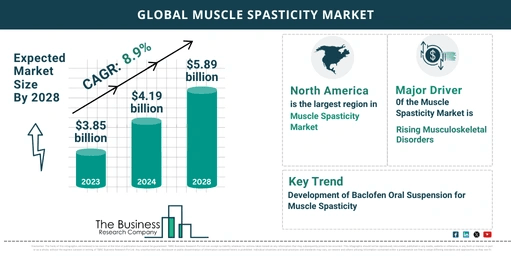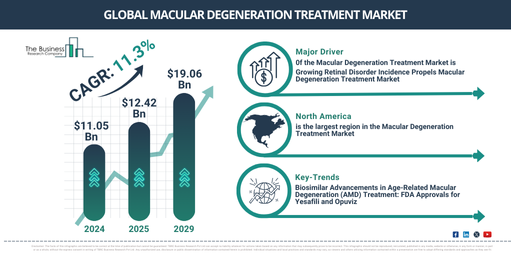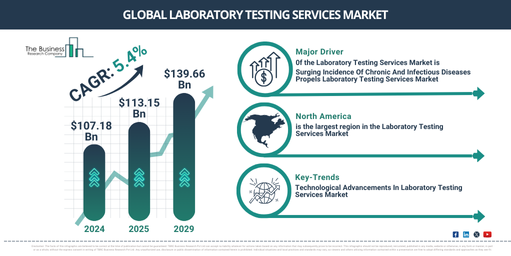Top 5 Insights From The Muscle Spasticity Market Report 2024
The Business Research Company’s global market reports are now updated with the latest market sizing information for the year 2024 and forecasted to 2033
According to The Business Research Company’s Muscle Spasticity Global Market Report 2024, the muscle spasticity market is expected to show promising growth in the forecast period.
Market Growth Overview
- The muscle spasticity market has seen robust growth in recent years.
- Valued at $3.85 billion in 2023, it is expected to reach $4.19 billion by 2024, with a CAGR of 8.8%.
- Key factors driving this growth include rising investments in research, regulatory approvals, and an increasing prevalence of conditions like multiple sclerosis.
Future Projections
- The market is set to continue growing, expected to hit $5.89 billion by 2028 with a CAGR of 8.9%.
- Factors contributing to this growth include a shift toward patient-centric care, enhanced drug delivery systems, and new biomarker discoveries.
Key Trends Shaping the Future
- Value-based reimbursement models: These are changing the way treatments are priced, focusing on outcomes and patient value.
- AI and machine learning integration: These technologies are revolutionizing diagnostics and treatment optimization.
- Telehealth and remote monitoring: The adoption of virtual care models is making patient management more accessible.
- Neurostimulation and regenerative medicine: These advanced therapies are being explored for muscle spasticity treatment.
View More On The Muscle Spasticity Market Report 2024 – https://www.thebusinessresearchcompany.com/report/muscle-spasticity-global-market-report
Musculoskeletal Disorders Driving Market Demand
- The rise of musculoskeletal disorders, such as those affecting muscles, bones, and joints, is a major driver.
- Contributing factors include aging populations, sedentary lifestyles, and chronic health conditions.
- A study published in The Lancetestimates that 494 million people globally suffered from musculoskeletal disorders in 2020, with a potential 115% increase by 2050.
Focus on Patient Quality of Life
- Muscle spasticity treatments aim to reduce pain, improve mobility, and enhance overall patient functionality.
- By addressing musculoskeletal disorders, treatments contribute significantly to improving patients’ daily lives.
Rising Osteoporosis Cases
- According to Amgen, fractures related to osteoporosis are expected to increase by 68% by 2040.
- This rise further underscores the need for effective spasticity treatments to manage associated complications.
Key Industry Players
- Major companies in the muscle spasticity market include F. Hoffmann-La Roche AG, AbbVie Inc., Novartis AG, Medtronic plc, and others.
- These companies are investing heavily in R&D, focusing on innovative treatments like oral suspensions to treat muscle spasms caused by conditions such as multiple sclerosis.
Innovative Drug Development
- In April 2024, ANI Pharmaceuticals launched baclofen oral suspension, a treatment for muscle spasms associated with spinal cord injuries.
- The market continues to innovate with new formulations and treatment options to enhance patient outcomes.
Regional Insights
- North America was the largest region in the muscle spasticity market in 2023.
- Asia-Pacific is forecasted to be the fastest-growing region, signaling a global shift in focus towards emerging markets.
Conclusion
- The muscle spasticity market is on a solid growth trajectory, driven by technological advancements, patient-centric innovations, and rising global demand.
- With a focus on improving quality of life, the industry is set to make significant strides in the coming years.
Request A Sample Of The Global Muscle Spasticity Market Report 2024:
https://www.thebusinessresearchcompany.com/sample_request?id=18411&type=smp



